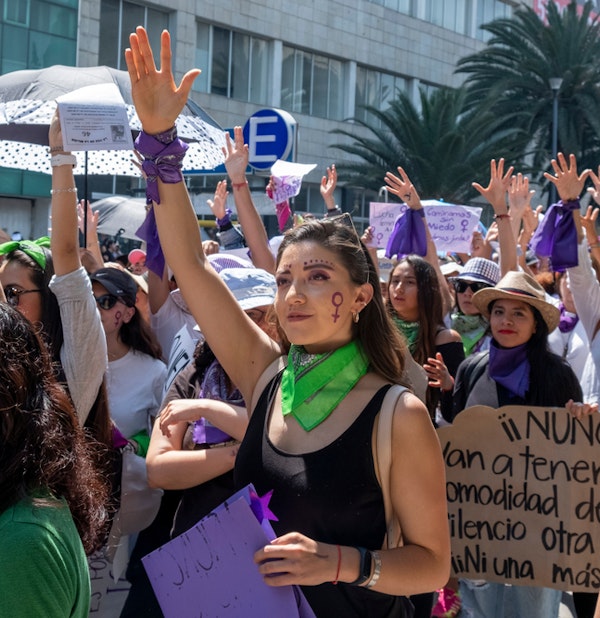Stopping Violence Against Women Stabilizes Nations and Communities
Violence against women is a scourge that undermines the common good. Here are ways to stop the violence and stabilize families, communities, and even nations.
 Women protesting "femicide" and gender-based violence in Mexico City in March 2020. (Soy Sendra/Shutterstock)
Women protesting "femicide" and gender-based violence in Mexico City in March 2020. (Soy Sendra/Shutterstock)
Violence against women and children knows no boundaries. It impacts every country and virtually every community around the world, carrying far-reaching economic, security, and moral implications. And yet sustained progress in preventing such violence remains elusive. If our societies truly aim to uproot gender inequity, all of us — including men and boys — will need to confront a scourge that undermines the common good.
The United Nations defines gender-based violence as any act that “results in, or is likely to result in, physical, sexual, or mental harm or suffering to women and girls, including threats of such acts, coercion or arbitrary deprivation of liberty, whether occurring in public or in private life.”
Simply put, this kind of violence is done to harm a person because of their gender. And it includes, but is not limited to, physical, sexual, emotional, economic, and psychological abuse. Astonishingly, one in three women have experienced some form of violence.
Simply put, this kind of violence is done to harm a person because of their gender.
Since COVID-19’s onset, the risk of violence only has increased for many women, children, and other vulnerable populations. At-risk women, for one, face worsening socioeconomic circumstances, inaccessible social safety nets, and the awful but real likelihood of being forced into lockdown with their abusers. According to a United Nations study of 13 countries, nearly one in two women reported direct or indirect experiences of violence since the start of the pandemic.
Those closest to women and girls, such as their intimate partners and family members, perpetrate most of the violence. The World Health Organization reported in 2018 that 26% of women ages 15 and older have already experienced intimate partner violence.
Femicide (the killing of a women or girls due to gender) is increasing, even in countries where homicides have seen a decrease. In the United States, nearly half of women killed in 47 major cities over a 10-year period were brutally murdered by an intimate partner.
Online, women, especially younger women, are more likely to experience sexual harassment than their male peers. A Plan International report examining the online experiences of 14,000 teenagers and young women across 31 countries revealed nearly 60% had experienced physical threats, cyberstalking, and other forms of online violence.
Online, women, especially younger women, are more likely to experience sexual harassment than their male peers.
Sadly, less than 40% of the women who experience violence seek help. And, again, the COVID-19 pandemic has only made seeking help harder due to added barriers such as mobility constraints or decreased access to essential support services.
A country cannot succeed when half a population is undervalued, unprotected, and abused.
 An Afghan burqa-clad woman walks with a child along a road in Kabul on September 9, 2021. (Photo by WAKIL KOHSAR/AFP via Getty Images)
An Afghan burqa-clad woman walks with a child along a road in Kabul on September 9, 2021. (Photo by WAKIL KOHSAR/AFP via Getty Images)
The impact of violence against women and girls
The UN puts the global cost of violence against women at $1.5 trillion. That equals approximately 2% of the global gross domestic product (GDP), or roughly the size of the entire Canadian economy.
Violence against women also directly affects access to education, employment training, and participation in the workforce. Naturally, this limits economic activity beyond individual households. An International Monetary Fund study of sub-Saharan Africa documents the severe constraints placed on economies during a financial downturn.
On top of all of this, violence against women and girls impacts national security, community safety, and the expansion of free and fair societies. Autocrats, extremists, and other rogue actors understand and embrace this reality. From the Taliban in Afghanistan to Burma’s military junta to Vladimir Putin’s actions in Russia, undermining the status of women in societies and encouraging physical abuse are rooted in their desire for control.
Their patriarchal regimes value men at the expense of women’s basic rights and well-being. Their brutal oppression of female populations contributes to the undermining of local societies and larger global stability.
History regularly demonstrates that nefarious actors embrace this sadistic tactic. And state-imposed inequity primes societies for further subordination of their female populations. At the same time, societies look away from abuses instead of decrying them.
… societies look away from abuses instead of decrying them.
Beyond the societal level, attacks on women and children undermine the safety and well-being of local communities. Research shows that witnessing abuse carries the same risk of harm to children’s mental health and learning as being abused directly.
In the United States, domestic violence incidents are some of the most highly dangerous and unpredictable response calls for law enforcement officers. Between 2011 and 2020, CNN reports, “Domestic disturbance or domestic violence calls accounted for roughly 8.5% of the total number of officers killed between 2011 and 2020.”
We all have a moral responsibility to respond
Most importantly, violence against women and children egregiously violates fundamental human rights. Think about this reality in these ways:
- What does it reflect about a society when 50% of a population faces a significant likelihood of harassment and assault?
- What does it demonstrate about the value we place on the inherent human dignity of all when social norms like toxic masculinity or “machismo” reinforce a daily threat of emotional, psychological, and physical abuse?
- What does it show about the strength and accountability of systems when laws and conventions aimed at protecting women and children project more symbolism than substance?
- What does it reveal about the character of a country where verbal abuse and misogyny are perpetrated with impunity, whether via the anonymity of the internet or from the most visible platforms of leadership?
Fortunately, numerous strategies can help advance the fight against gender-based violence. Here are some:
- Greater investments in data that documents the experiences and needs of the most-impacted populations. Stakeholders cannot effectively mobilize solutions if the scale and scope of a problem remains unknown. Infosegura’s innovative dashboard and analysis examining the issue of violence against women in six Central American countries offers a standout example of what is possible and why it matters.
- Increased support for and inclusion of local organizations and advocates at policymaking tables. Those working on the frontlines uniquely understand the influence of violence on at-risk communities. They also know what can block sustainable interventions. Their real-world experience can help develop policies and investments that positively impact women and children.
- Improved access to survivor support services, especially in ways that meet at-risk communities where they are. In Guatemala City, the non-profit Creamos innovatively integrates best practices into its community outreach. The organization even uses joy-inspired opportunities, like Zumba classes, to build trust with local women. By opening lifelines, the nonprofit bypasses the stigma so often associated with services for mental health care and support for survivors.
- Strengthening of rule of law and justice systems. While most countries have laws addressing domestic and sexual violence, access to justice for survivors of violence remains elusive. The UN’s Spotlight Initiative and organizations like the International Justice Mission confront these challenges. Still, nations and communities alike need better collaboration and engagement across their public and private sectors.
 International Women's Day was marked in 2015 with a march in Times Square.
International Women's Day was marked in 2015 with a march in Times Square.
Men and boys need to help prevent abuse
Projecting positive gender norms, however, remains one of the most critical needs. Communities need to actively engage men and boys in helping eradicate violence against women and children. This means working with them to confront harmful behaviors, perceptions, and customs.
Unfortunately, a 2019 BMJ Global Health study examining health efforts specifically, reports that only “8% of interventions that involve men and boys actually challenge male norms or unequal power privileging men over women.” New and expanded resources are very needed in this area. Direct outreach to male communities opens channels of communication, enhances advocacy, and contributes to successful interventions.
Challenging and demolishing harmful gender norms and their acceptance within society is critical. Campaigns and programs from organizations and offices like the Spouses of CARICOM Leaders Action Network (SCLAN), the Office of the First Lady of Namibia (Break Free campaign), and Proctor & Gamble (Gillette) offer innovative examples. They encourage the projection of positive gender norms.
What I am suggesting is not an attack on masculinity or the status of men within a society. Rather, this is an opportunity to affirm positive gender norms, dismantle archetypes and beliefs that have reinforced inequity, and demonstrate that the dignity and protection of all matters to the common good.
We are all are stronger when women are valued and respected.
The Catalyst believes that ideas matter. We aim to stimulate debate on the most important issues of the day, featuring a range of arguments that are constructive, high-minded, and share our core values of freedom, opportunity, accountability, and compassion. To that end, we seek out ideas that may challenge us, and the authors’ views presented here are their own; The Catalyst does not endorse any particular policy, politician, or party.


